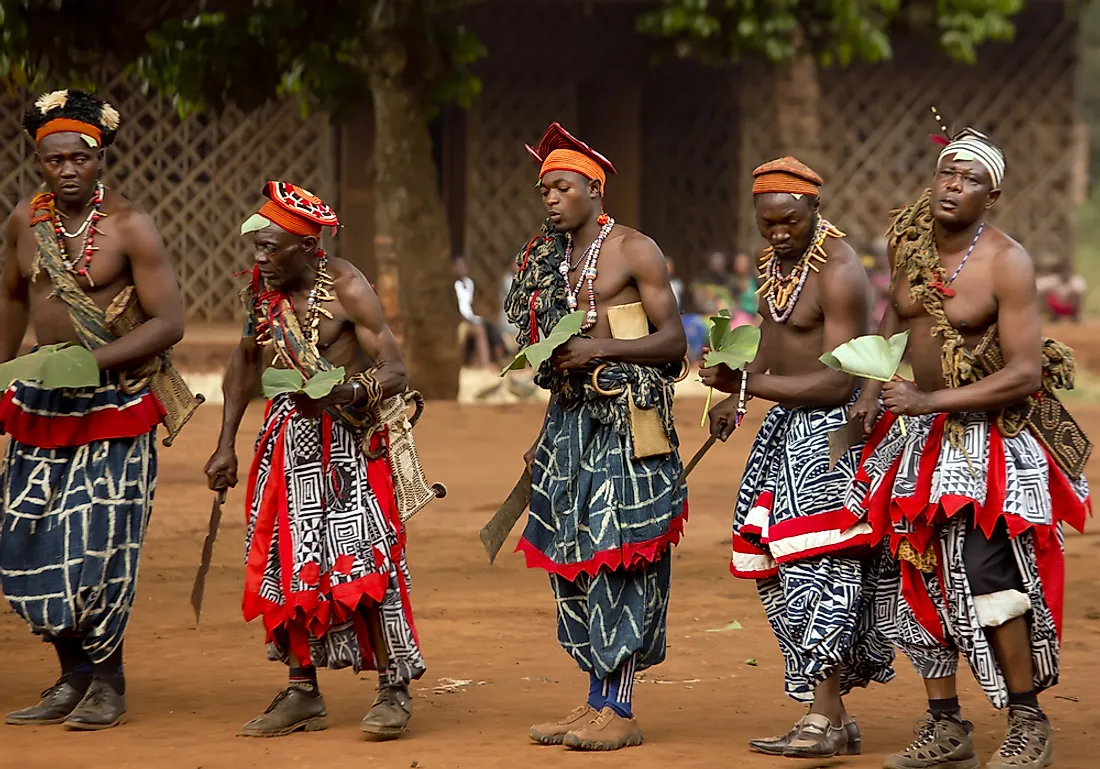Ethnic Groups Of Cameroon

Cameroon is an ethnically diverse country with about 250 groups. Some of the groups are interrelated while others have been assimilated into other groups through years of interaction. These ethnic groups mainly fall under the Bantu, Semitic, and Nilotic language groups. Cameroon’s ethnic community are known to coexist in peace, and no particular group holds any political influence over the affairs of the country. The groups contribute to the country’s cultural diversity.
Ethnic Groups Of Cameroon
The Bamileke
The Bamileke is a semi-Bantu community in Cameroon with origins from Egypt. The Bamileke occupy the northwest and western highlands of Cameroon. The ethnic group is composed of other related tribes with whom they share a common ancestry forming the largest group at 38% of the total population. The tribes include Bamum, Tikar and other people of the Western highlands. Languages spoken by the Bamileke include variants of Ghomala, Fe’fe, Yemba, Medumba, and Kwa. Traditionally, their system of government was patriarchal and hereditary. Being a dynamic and entrepreneurial community, the Bamileke can be found in almost all parts of Cameroon and some parts of the world. Since they are a Bantu community, their primary activities revolve around agriculture, an activity which is mainly handled by women.
The Beti-Pahuin
The Beti-Pahuin are a Bantu ethnic community occupying the southern rainforest regions of Cameroon. The Beti-Pahuin shares a common origin with the Fang, Njem, Bulu and Baka among others. Though their origins are unclear, it is believed that the Beti-Pahuin people migrated from Sudan. In Cameroon, the group was displaced severally from their locations by the Jihad and Fula who were forcing communities to convert to Islam. During these movements, some of the groups that interacted with the Beti-Pahuin were assimilated. Others such as Maka resisted assimilation and fled south and east. The Beti-Pahuin served as middlemen during the European trade. The Germans exploited them for slave labour, road construction and as sexual prisoners leading to a series of conflict. Due to their involvement in cocoa farming, the Beti-Pahuin have a strong economic influence.
The Duala people
The Duala are a Bantu coastal Cameroonian ethnic group who are highly educated due to long-term contact with the Europeans. The Doula shares a common origin with people such as the Ewodi, Isubu, Batanga, Bakoko, and the Bassa forming 12% of the total population. The primary language spoken is Douala. The Doula traces their origin to Gabon or Congo after which they moved to their present locations. During their movement, they displaced the Bassa and Bakoko who they later assimilated. The Duala were mainly traders and cultivators, which have remained part of their economic activities to the present day. Their success in trade declined significantly during the German rule after which they prospered again during the French rule. Most of the Duala are Christians.
Kirdi
Kirdi is a group of people occupying north-western Cameroon. The name Kirdi means pagan and was used to refer to a group of people who refused to join the Islamic faith. The group makes up 18% of the total population. Among the members of Kirdi are Bata, Fata, Mada, Mara, and Toupori. The Kirdi speak Chadic and Adamawa languages.
Fulani and Sahelian Muslims
The Fulani are a nomadic tribe in Cameroon which forms about 14% of the total population. The Fulani are Muslims who speak Pulaar language. The Fulani had a religious and cultural dominance over the local people forcing most of them to convert to Islam while others fled from their homes. Their culture is highly influenced by Islamic practices.
Ethnic Groups Of Cameroon
| Rank | Ethnic Groups | Share of Population of Cameroon |
|---|---|---|
| 1 | Bamileke, Bamum, Tikar, and other Peoples of the Western Highlands | 38% |
| 2 | Beti-Pahuin, Bulu, Fang, Maka, Njem, Baka, and other Peoples of the Southern Forests | 18% |
| 3 | Bassa, Duala, and other Peoples of the Coastal Forests | 12% |
| 4 | Kirdi | 18% |
| 5 | Fulani and Sahelian Muslims | 14% |











